Any day outdoors
View Sequence overviewStudents will:
- identify clouds as a feature of the sky.
- describe how much of the sky is covered by cloud.
Students will represent their understanding as they:
- discuss their experiences of observing and recording the weather.
- make observations of the sky.
- discuss language used to describe the amount of cloud cover.
- represent observations of cloud cover and label appropriately.
In this lesson, assessment is formative.
Feedback might focus on:
- Can students record observations through text, drawing or digital photography?
- Are students able to observe and use a varied vocabulary to describe the sky?
- Are students able to informally compare the amount of cloud cover in the sky?
- Are students able to use their observations of the sky to predict rain?
Whole class
Class science journals (digital or hard-copy)
Word wall
Weather watch class table
Demonstration copy of Eye to the sky Resource sheet
Factual texts about the weather
Optional: photographs of the sky
Optional: digital camera or iPads
Each student
Individual science journal (digital or hard-copy)
Frame from Lesson 1
Lesson
The Inquire phase allows students to cycle progressively and with increasing complexity through the key science ideas related to the core concepts. Each Inquire cycle is divided into three teaching and learning routines that allow students to systematically build their knowledge and skills in science and incorporate this into their current understanding of the world.
When designing a teaching sequence, it is important to consider the knowledge and skills that students will need in the final Act phase. Consider what the students already know and identify the steps that need to be taken to reach the level required. How could you facilitate students’ understanding at each step? What investigations could be designed to build the skills at each step?
Read more about using the LIA FrameworkRe-orient
Review the weather watch table and add today's entry. Discuss what the class has observed and recorded about the weather.
Review the previous lesson. Focus on the weather symbols for clouds: both the ones students created and the ones used by weather apps/websites.
The Inquire phase allows students to cycle progressively and with increasing complexity through the key science ideas related to the core concepts. Each Inquire cycle is divided into three teaching and learning routines that allow students to systematically build their knowledge and skills in science and incorporate this into their current understanding of the world.
When designing a teaching sequence, it is important to consider the knowledge and skills that students will need in the final Act phase. Consider what the students already know and identify the steps that need to be taken to reach the level required. How could you facilitate students’ understanding at each step? What investigations could be designed to build the skills at each step?
Read more about using the LIA FrameworkIdentifying and constructing questions is the creative driver of the inquiry process. It allows students to explore what they know and how they know it. During the Inquire phase of the LIA Framework, the Question routine allows for past activities to be reviewed and to set the scene for the investigation that students will undertake. The use of effective questioning techniques can influence students’ view and interpretation of upcoming content, open them to exploration and link to their current interests and science capital.
When designing a teaching sequence, it is important to spend some time considering the mindset of students at the start of each Inquire phase. What do you want students to be thinking about, what do they already know and what is the best way for them to approach the task? What might tap into their curiosity?
Read more about using the LIA FrameworkCloud cover predictions
Discuss how students know about the day’s weather. Encourage them to consider that looking at the sky often helps us predict or know about the weather, and that when observing the sky it is important to see as much of it as possible.
Ask students: Do you think we will see clouds in the sky on a day like today? What sort of clouds might we see? Why do you think that?
The Inquire phase allows students to cycle progressively and with increasing complexity through the key science ideas related to the core concepts. Each Inquire cycle is divided into three teaching and learning routines that allow students to systematically build their knowledge and skills in science and incorporate this into their current understanding of the world.
When designing a teaching sequence, it is important to consider the knowledge and skills that students will need in the final Act phase. Consider what the students already know and identify the steps that need to be taken to reach the level required. How could you facilitate students’ understanding at each step? What investigations could be designed to build the skills at each step?
Read more about using the LIA FrameworkThe Investigate routine provides students with an opportunity to explore the key ideas of science, to plan and conduct an investigation, and to gather and record data. The investigations are designed to systematically develop content knowledge and skills through increasingly complex processes of structured inquiry, guided inquiry and open inquiry approaches. Students are encouraged to process data to identify trends and patterns and link them to the real-world context of the teaching sequence.
When designing a teaching sequence, consider the diagnostic assessment (Launch phase) that identified the alternative conceptions that students held. Are there activities that challenge these ideas and provide openings for discussion? What content knowledge and skills do students need to be able to complete the final (Act phase) task? How could you systematically build these through the investigation routines? Are there opportunities to build students’ understanding and skills in the science inquiry processes through the successive investigations?
Read more about using the LIA FrameworkDescribing cloud cover
Take students outside to an open space and provide each student with a frame, as used in Lesson 1. Encourage the students to view and describe the sky by looking in front, to the right, to the left and behind. Through discussion, they might learn that the sky can look different from different directions.
Note: Looking directly at the Sun can cause permanent eye damage. In rare cases this might occur without any pain. Warn students against looking directly at the Sun at any time.
Discuss:
- how these four views can be used to build a picture of what the sky is really like and can more accurately describe the sky.
- different words we can use to describe the sky, such as ‘empty sky’, ‘blue sky’, ‘grey sky’, 'lots of clouds' or 'white clouds'. Record student ideas.
- how much cloud cover students think there is. You might like to introduce the scientific descriptions of cloud cover if you feel it is appropriate for your students: clear (no cloud), cloudy (more cloud than clear sky), scattered cloud (smaller clouds scattered over the sky) and overcast (total cloud cover). Some students might also make a connection between the amount of cloud cover in the sky and brightness.
Make recordings of the cloud cover.
- LOW TECH: Use a digital camera to record the cloud cover.
- HIGH TECH: Use student iPads or digital devices to record the cloud cover.
Discuss and list observations in the class science journal.
Create a class table to describe different levels of cloud cover. Review the purpose and features of a table. Discuss the headings and what information will go into each column.
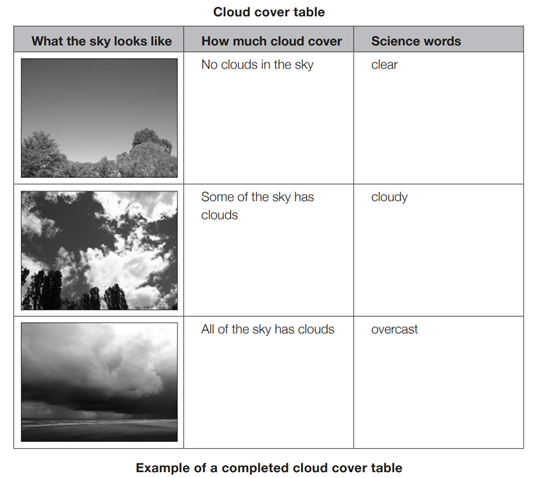
The science of clouds
How are clouds formed? How do meteorologists talk about cloud cover?
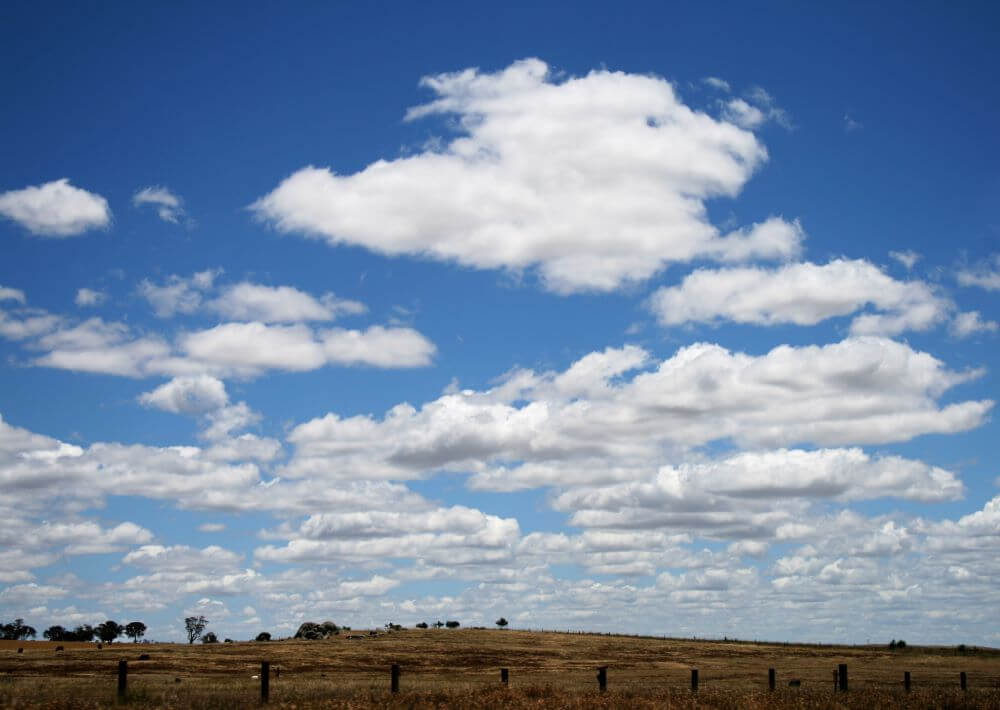
Clouds are formed when warm moist air (water gas = vapour) rises to where it is cooler and the pressure in the atmosphere is lower. As the warm moist air cools (all gases cool when they expand under low pressure), some of the water vapour in the air changes from a gas to a liquid (condenses), forming tiny water droplets. A mass of billions of these tiny suspended water droplets is visible as a cloud. Rain develops when water droplets join together and become too heavy to be suspended in air currents and remain in the cloud. Gravity pulls the droplets towards the surface of the Earth, where they fall as precipitation.
When estimating cloud cover, meteorologists divide the sky into eighths. If they estimate that eight-eighths are covered by clouds, they describe the sky as having total cloud cover. If they estimate that zero parts are covered, they describe the sky as being clear. In weather forecasts, the terminology used is simpler: clear (no cloud), sunny (little chance of the Sun being obscured by cloud), cloudy (more cloud than clear sky) and overcast (total cloud cover).
Clouds are formed when warm moist air (water gas = vapour) rises to where it is cooler and the pressure in the atmosphere is lower. As the warm moist air cools (all gases cool when they expand under low pressure), some of the water vapour in the air changes from a gas to a liquid (condenses), forming tiny water droplets. A mass of billions of these tiny suspended water droplets is visible as a cloud. Rain develops when water droplets join together and become too heavy to be suspended in air currents and remain in the cloud. Gravity pulls the droplets towards the surface of the Earth, where they fall as precipitation.
When estimating cloud cover, meteorologists divide the sky into eighths. If they estimate that eight-eighths are covered by clouds, they describe the sky as having total cloud cover. If they estimate that zero parts are covered, they describe the sky as being clear. In weather forecasts, the terminology used is simpler: clear (no cloud), sunny (little chance of the Sun being obscured by cloud), cloudy (more cloud than clear sky) and overcast (total cloud cover).
The Inquire phase allows students to cycle progressively and with increasing complexity through the key science ideas related to the core concepts. Each Inquire cycle is divided into three teaching and learning routines that allow students to systematically build their knowledge and skills in science and incorporate this into their current understanding of the world.
When designing a teaching sequence, it is important to consider the knowledge and skills that students will need in the final Act phase. Consider what the students already know and identify the steps that need to be taken to reach the level required. How could you facilitate students’ understanding at each step? What investigations could be designed to build the skills at each step?
Read more about using the LIA FrameworkFollowing an investigation, the Integrate routine provides time and space for data to be evaluated and insights to be synthesized. It reveals new insights, consolidates and refines representations, generalises context and broadens students’ perspectives. It allows student thinking to become visible and opens formative feedback opportunities. It may also lead to further questions being asked, allowing the Inquire phase to start again.
When designing a teaching sequence, consider the diagnostic assessment that was undertaken during the Launch phase. Consider if alternative conceptions could be used as a jumping off point to discussions. How could students represent their learning in a way that would support formative feedback opportunities? Could small summative assessment occur at different stages in the teaching sequence?
Read more about using the LIA FrameworkDrawing cloud observations
Invite students to use their science journals to draw a picture of the sky as they observed it and to write a caption (or for you to scribe) that describes the cloud cover.
Discuss: Does every cloud bring rain? Emphasise that clouds are made up of tiny water droplets. When the drops start joining together, they become heavy and fall as rain.
Add the new vocabulary to the word wall. If possible, include photographs of the sky as a cue for students reading the words.
Review the question page in the class science journal for questions on clouds.
Link the discussion of clouds back to the Launch phase by asking students if the type of clouds in a sky will affect the picnic (or other outdoors event). Explain that some weather might affect how they plan for the picnic, and that there are a lot of decisions to be made when going on a picnic.
As a class, build a list of decisions that will need to be made in preparation for the event. For example:
- the food to take.
- what to wear.
- where to go.
- what to do if it rains.
- what to do if it is too hot.
- whether the class pet can come, and what it may need.
Explain that when there is a lot of information to think about, it might need to be sorted. A decision tree can help sort information and make decisions. Provide an example of a decision tree for where to eat lunch or to wear a hat (‘no hat, no play’), adapting based on your school rules.
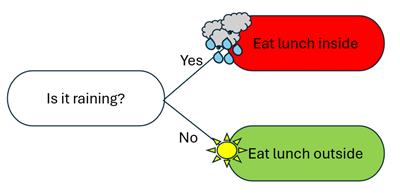
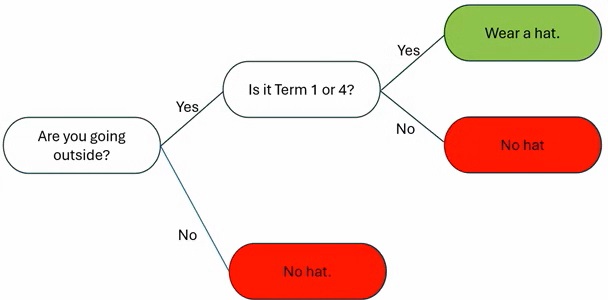
Invite students to make a decision tree to help them decide which day would have good weather for a picnic.
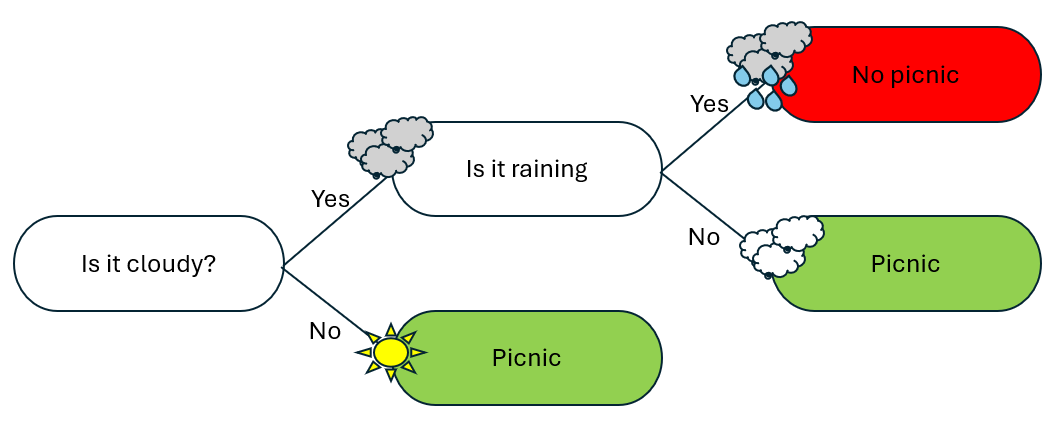
Discuss if clouds or rain will stop a picnic. This is a good opportunity to reinforce that cloud cover do not always indicate that it will rain.
Review the students’ question page in the class science journal and review the questions related to clouds and rain. Add any new questions students might have.
Reflect on the lesson
You might:
- add to/review the class word wall.
- review the agreed upon symbol for clouds and determine if it/they cover all the different types of clouds discussed during the lesson.
- make predictions about tomorrow's weather.
- review the students’ question page in the class science journal and review the questions related to wind. Add any new questions students might have.
Weather watch table
From this point, when observing and recording daily weather for the weather watch class table, highlight details about the amount of cloud cover using scientific language where appropriate. Remember to discuss clothing and activities that might be suited to the season and the particular type of weather conditions.
Curriculum link to The Arts
Creating a picture of the sky can link to the visual arts curriculum.

Creating a picture of the sky provides students with an opportunity to develop practices and skills (AC9AVA2D01) and create and make (AC9AVA2C01) by observing cloud movement and shapes, and create an artwork to show what they have seen and imagined. Students can describe their cloud pictures orally or in writing.
Creating a picture of the sky provides students with an opportunity to develop practices and skills (AC9AVA2D01) and create and make (AC9AVA2C01) by observing cloud movement and shapes, and create an artwork to show what they have seen and imagined. Students can describe their cloud pictures orally or in writing.
Decision tree
A decision tree is a visual representation of algorithmic thinking.

A decision tree is a visual representation of algorithmic thinking. It can guide students to consider the thinking pathway used to solve a complex problem that has many different facets, such as catering for everyone’s needs when planning a picnic. A fully formed complex decision tree can be intimidating for young students. This teaching sequence will contribute to the decision tree as students investigate rain and temperature, and their effects on plants and animals.
A decision tree is a visual representation of algorithmic thinking. It can guide students to consider the thinking pathway used to solve a complex problem that has many different facets, such as catering for everyone’s needs when planning a picnic. A fully formed complex decision tree can be intimidating for young students. This teaching sequence will contribute to the decision tree as students investigate rain and temperature, and their effects on plants and animals.